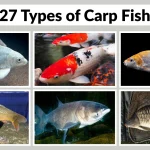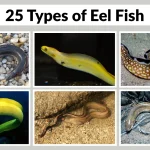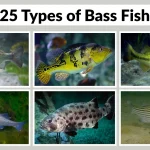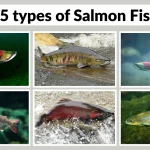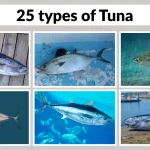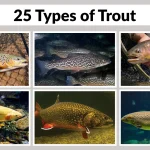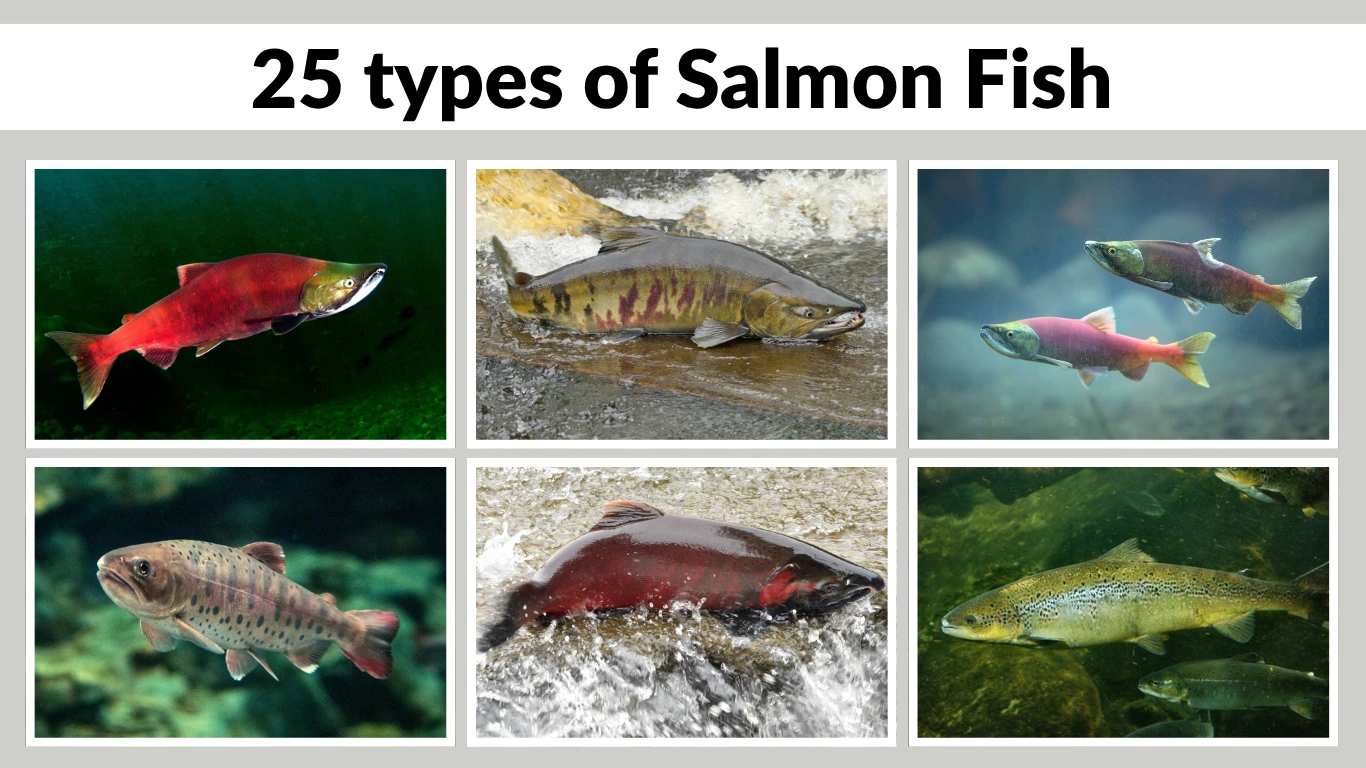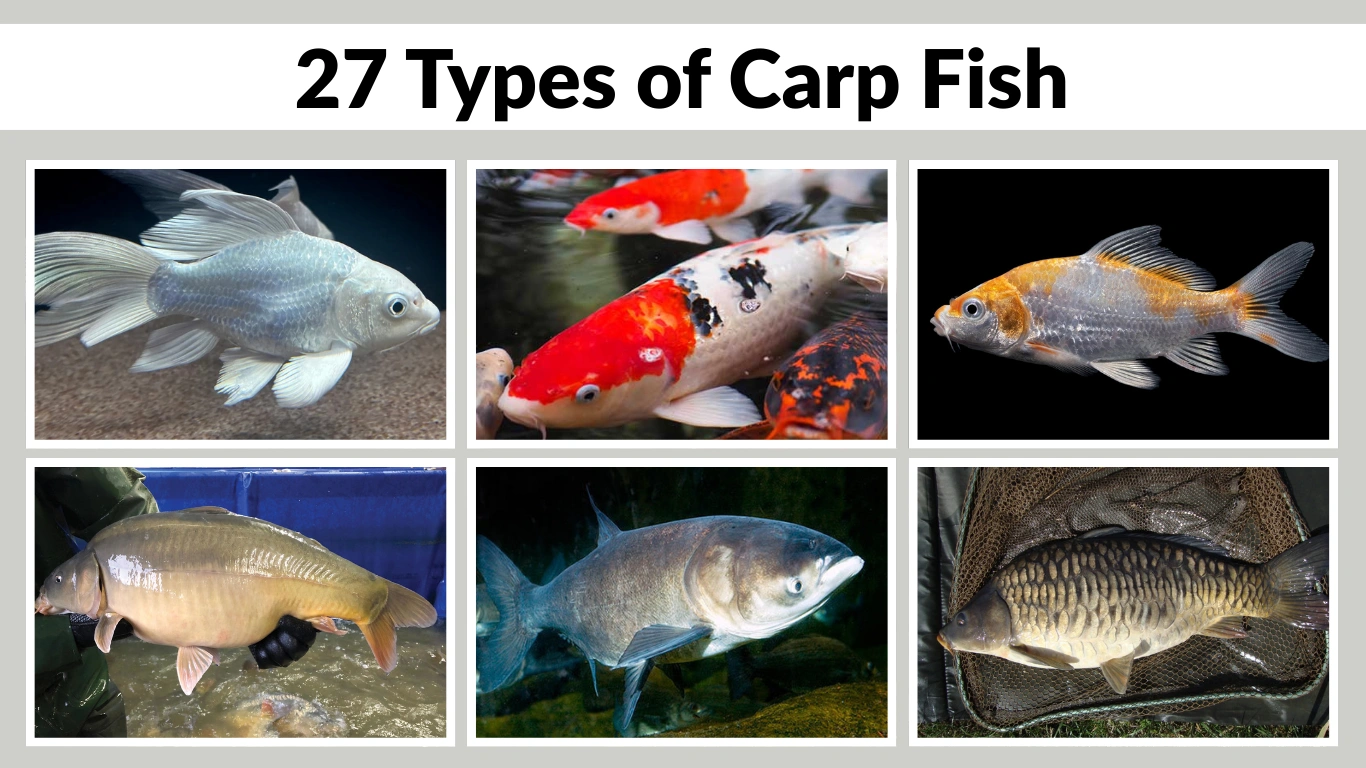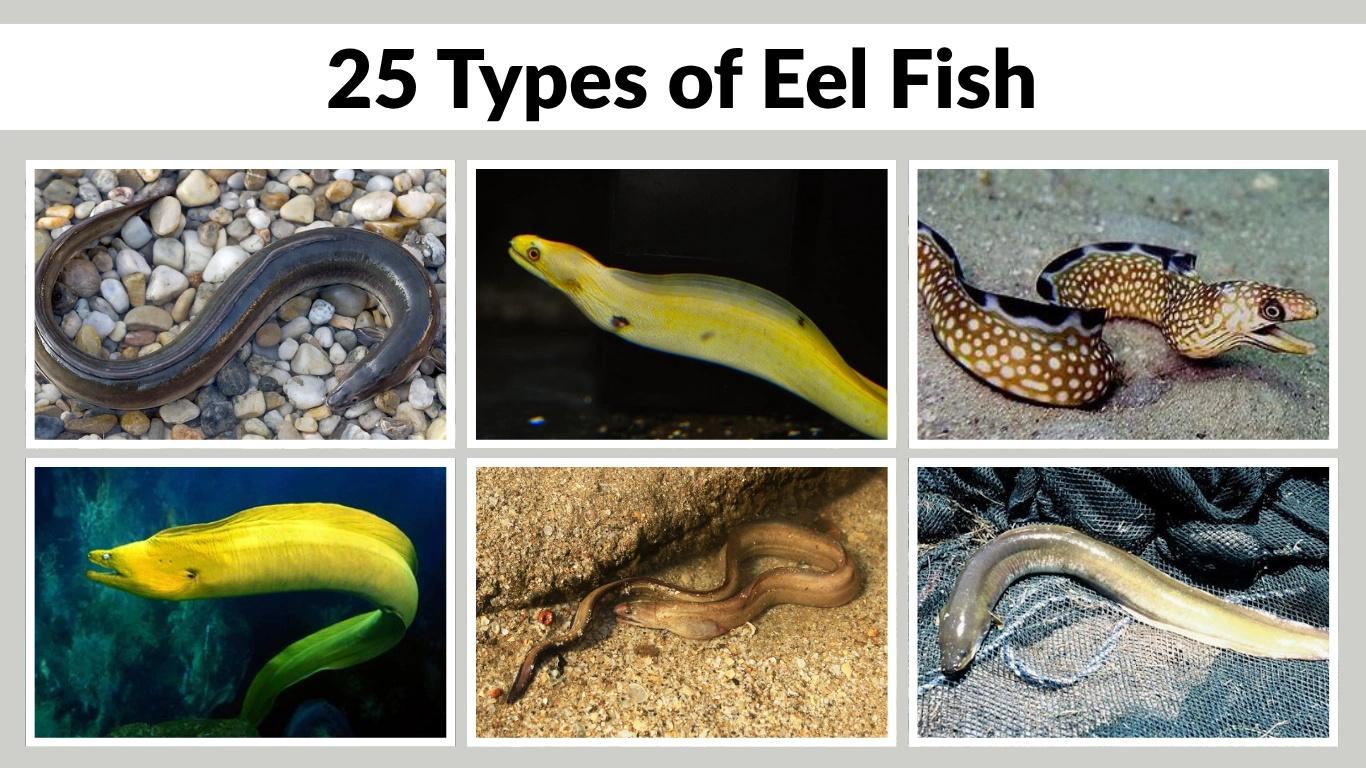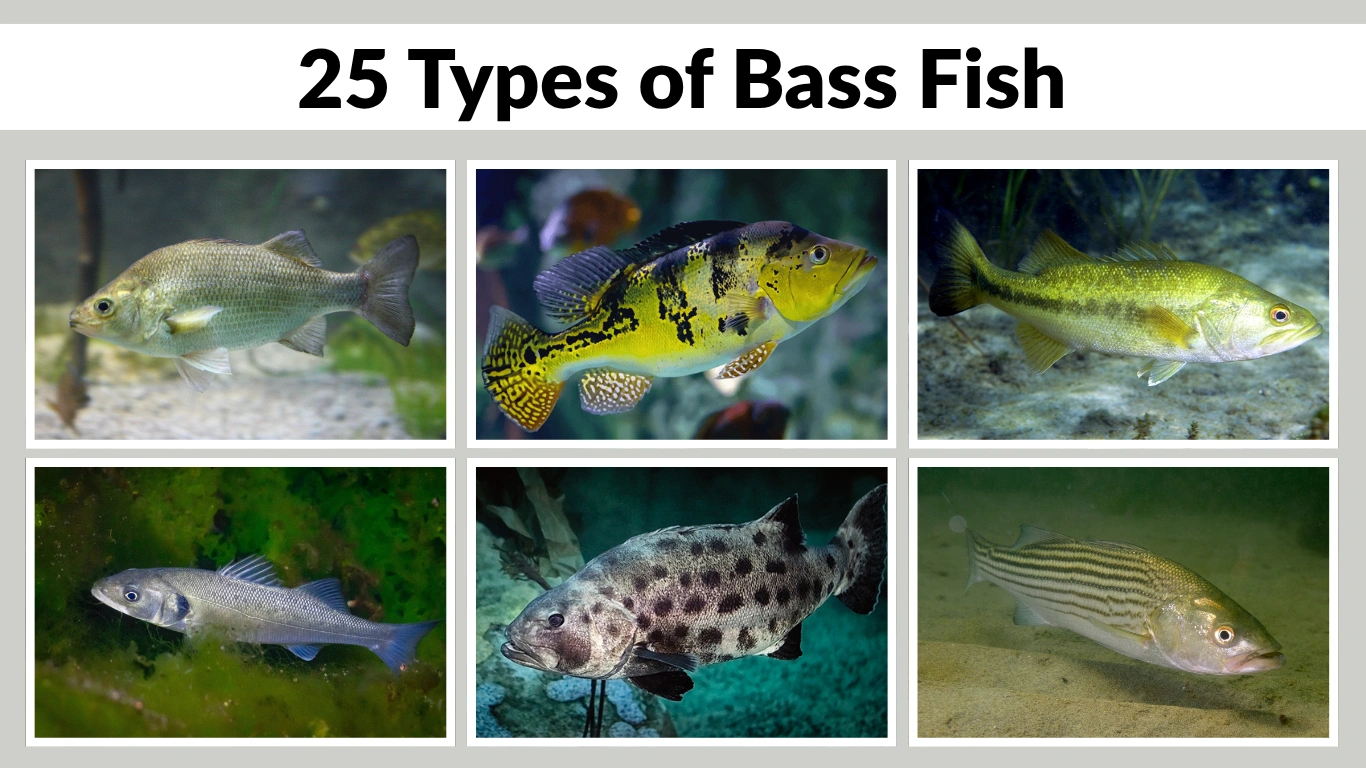Salmon are among the most iconic and valuable fish species in the world, admired for their incredible migrations, ecological importance, and delicious, nutrient-rich meat. Found across the Northern Hemisphere, they range from massive Chinooks to brilliantly colored sockeyes. In this guide, we’ll explore 25 distinct types of salmon, each with its scientific name and unique identification features, helping you recognize and appreciate these remarkable fish.
1. Atlantic Salmon (Salmo salar)
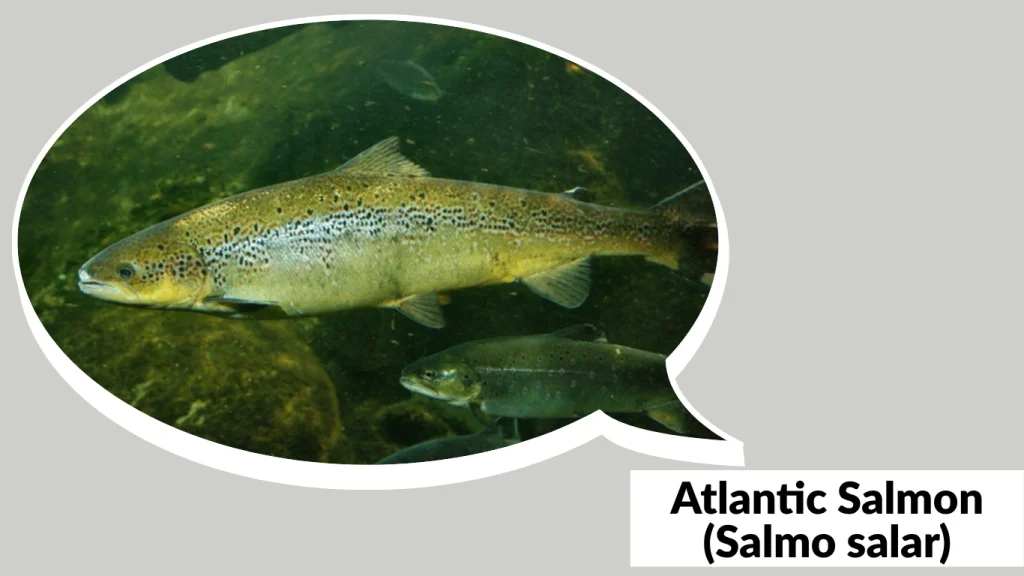
The Atlantic salmon is one of the most iconic and commercially important fish species in the world. Known for its remarkable migratory journey from freshwater rivers to the open ocean and back, it is highly valued for both sport fishing and its rich, flavorful meat. Atlantic salmon populations are found naturally in the North Atlantic, though they are also farmed globally.
Identification
- Common Name: Atlantic Salmon
- Scientific Name: Salmo salar
- Size: Typically 28–30 inches, weighing 8–12 lbs (can grow larger)
- Color: Silvery body with small black spots, turning darker during spawning
- Shape: Streamlined body with a slightly forked tail
- Habitat Type: Freshwater rivers (spawning) and North Atlantic Ocean (feeding)
Habitat and Distribution
Wild Atlantic salmon are native to the North Atlantic Ocean and rivers of Europe and North America. They spawn in freshwater streams before migrating to the ocean, returning to their natal rivers to reproduce.
Behavior and Diet
Atlantic salmon are anadromous, meaning they live in both fresh and saltwater during their life cycle. Their diet includes insects, crustaceans, and small fish in freshwater, while in the ocean they feed on capelin, herring, and sand eels.
2. Chinook Salmon (Oncorhynchus tshawytscha)
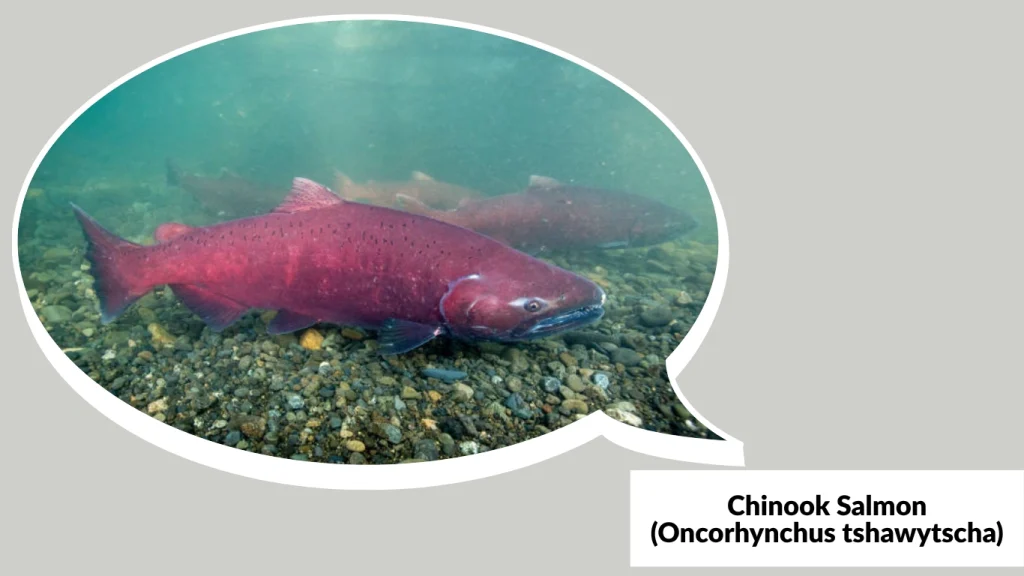
The Chinook salmon, also known as the king salmon, is the largest of all Pacific salmon species. Prized by anglers for its size and strength, it is also highly valued for its rich, high-oil content flesh. These powerful fish undertake long migrations from the ocean to their spawning rivers, making them an important part of both ecological systems and fishing industries.
Identification
- Common Name: Chinook Salmon / King Salmon / Quinnat Salmon
- Scientific Name: Oncorhynchus tshawytscha
- Size: Commonly 24–36 inches, can exceed 50 inches and 100 lbs
- Color: Blue-green back, silver sides, and black spots on back and tail
- Shape: Thick, robust body with a slightly forked tail
- Habitat Type: Freshwater rivers (spawning) and Pacific Ocean (feeding)
Habitat and Distribution
Chinook salmon are native to the North Pacific Ocean and river systems from California to Alaska in North America, and from northern Japan to the Arctic coast in Asia.
Behavior and Diet
They are anadromous, feeding on squid, herring, sand lance, and other small fish at sea. In freshwater, they stop feeding before spawning, relying on stored body energy to complete their life cycle.
3. Coho Salmon (Oncorhynchus kisutch)

The Coho salmon, also known as the silver salmon, is admired for its bright silver body and energetic fighting spirit, making it a favorite among sport fishers. Its firm, flavorful meat is also highly sought after in the culinary world. Coho salmon are smaller than Chinooks but still undertake impressive ocean-to-river migrations.
Identification
- Common Name: Coho Salmon / Silver Salmon
- Scientific Name: Oncorhynchus kisutch
- Size: Typically 24–28 inches, weighing 8–12 lbs
- Color: Bright silver sides with a metallic blue back; black spots on the upper lobe of the tail
- Shape: Sleek body with a slightly forked tail
- Habitat Type: Freshwater rivers (spawning) and Pacific Ocean (feeding)
Habitat and Distribution
Native to the North Pacific Ocean, Coho salmon are found from Alaska to central California in North America and from Russia to northern Japan in Asia.
Behavior and Diet
In the ocean, they feed on anchovies, herring, and squid. During freshwater spawning migrations, they stop feeding and rely on stored fat reserves.
4. Sockeye Salmon (Oncorhynchus nerka)

Sockeye salmon, often called red salmon due to their vibrant coloration during spawning, are known for their rich flavor and deep red flesh. They are also unique among salmon for their reliance on lake systems during their life cycle.
Identification
- Common Name: Sockeye Salmon / Red Salmon / Blueback Salmon
- Scientific Name: Oncorhynchus nerka
- Size: Usually 18–30 inches, weighing 4–15 lbs
- Color: Silvery blue in the ocean; turns bright red with a green head during spawning
- Shape: Slim, streamlined body with a slightly forked tail
- Habitat Type: Freshwater lakes and rivers (spawning) and Pacific Ocean (feeding)
Habitat and Distribution
Sockeye salmon are found in the North Pacific Ocean from Alaska to northern California and from Siberia to northern Japan, often spawning in lakes connected to river systems.
Behavior and Diet
In freshwater, juveniles feed on plankton before heading to the ocean, where adults consume zooplankton, shrimp, and small fish.
5. Pink Salmon (Oncorhynchus gorbuscha)

Pink salmon, also known as humpback salmon, are the smallest and most abundant of the Pacific salmon species. They are easily recognized during spawning season by the pronounced hump that develops on the backs of males. Despite their smaller size, they play a crucial role in the marine food web and commercial fisheries.
Identification
- Common Name: Pink Salmon / Humpback Salmon
- Scientific Name: Oncorhynchus gorbuscha
- Size: Typically 18–24 inches, weighing 3–5 lbs
- Color: Silvery in the ocean; turns pinkish-gray with a pronounced hump in spawning males
- Shape: Slender body with a deeply forked tail
- Habitat Type: Freshwater rivers (spawning) and Pacific Ocean (feeding)
Habitat and Distribution
Pink salmon are native to the Pacific Ocean and rivers from California to Alaska, and across to Russia, Korea, and Japan.
Behavior and Diet
They are strict two-year spawners, returning to their natal streams exactly two years after hatching. In the ocean, they feed on plankton, small fish, and squid.
6. Chum Salmon (Oncorhynchus keta)

Chum salmon, also known as dog salmon, are known for their large size and distinctive spawning colors, with males developing striking vertical stripes. They are an important species for commercial fishing, particularly for their roe, which is highly valued in global markets.
Identification
- Common Name: Chum Salmon / Dog Salmon / Silverbrite Salmon
- Scientific Name: Oncorhynchus keta
- Size: Commonly 24–28 inches, weighing 8–15 lbs (can exceed 30 lbs)
- Color: Silvery blue-green in the ocean; dark green and purple vertical bars during spawning
- Shape: Robust, elongated body with a slightly forked tail
- Habitat Type: Freshwater rivers (spawning) and Pacific Ocean (feeding)
Habitat and Distribution
Native to the North Pacific Ocean, Chum salmon range from California to Alaska in North America and from Japan to the Arctic coast in Asia.
Behavior and Diet
In the ocean, they feed mainly on zooplankton, squid, and small fish. They often spawn in lower river sections compared to other salmon species.
7. Masu Salmon (Oncorhynchus masou)

Masu salmon, also called cherry salmon, are a prized species in East Asia, especially in Japan, for both sport fishing and cuisine. They are renowned for their beautiful coloration during spawning and their relatively smaller, yet flavorful, flesh compared to other salmon species.
Identification
- Common Name: Masu Salmon / Cherry Salmon
- Scientific Name: Oncorhynchus masou
- Size: Typically 12–20 inches, weighing 2–5 lbs
- Color: Silvery in the ocean; turns reddish-pink with dark spots during spawning
- Shape: Streamlined body with small black spots on the back and upper sides
- Habitat Type: Freshwater rivers (spawning) and North Pacific coastal waters (feeding)
Habitat and Distribution
Masu salmon are native to the western Pacific Ocean, particularly around Japan, Korea, Russia’s Far East, and Taiwan.
Behavior and Diet
They are anadromous, feeding on insects, crustaceans, and small fish in rivers, and shifting to squid, krill, and smaller fish in the ocean. Some populations remain entirely in freshwater.
8. Amago Salmon (Oncorhynchus masou macrostomus)

The Amago salmon is a subspecies of the Masu salmon, distinguished by its striking red spots along its sides. It is highly valued in Japan, both as a game fish and for its delicate flavor. Unlike many other salmon species, Amago can be found in both anadromous and landlocked freshwater forms.
Identification
- Common Name: Amago Salmon
- Scientific Name: Oncorhynchus masou macrostomus
- Size: Typically 10–16 inches, weighing 1–3 lbs
- Color: Silvery body with distinctive red spots along the lateral line; darker back with small black spots
- Shape: Slender body with a slightly forked tail
- Habitat Type: Freshwater rivers and streams, with some anadromous populations migrating to coastal waters
Habitat and Distribution
Native to western Japan, particularly the rivers flowing into the Seto Inland Sea and surrounding coastal regions.
Behavior and Diet
Feeds on aquatic insects, small crustaceans, and small fish. Anadromous populations migrate to the ocean to feed before returning to rivers to spawn, while landlocked populations remain in freshwater their entire lives.
9. Biwa Salmon (Oncorhynchus masou rhodurus)
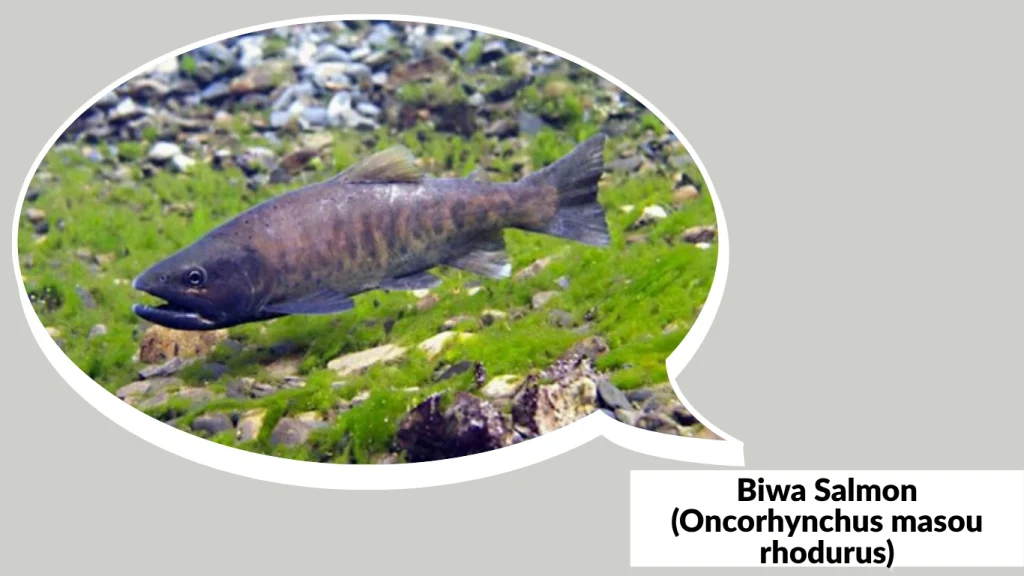
The Biwa salmon is a rare, landlocked subspecies of the Masu salmon, found exclusively in Japan’s Lake Biwa. Known for its unique habitat and limited distribution, it holds cultural and culinary significance in the region. Its flavor is delicate, and it is often served as a local delicacy in traditional Japanese cuisine.
Identification
- Common Name: Biwa Salmon
- Scientific Name: Oncorhynchus masou rhodurus
- Size: Typically 12–20 inches, weighing 2–6 lbs
- Color: Silvery body with faint spots; during spawning, males may show a light pink hue
- Shape: Streamlined body similar to other Masu salmon, but slightly more elongated
- Habitat Type: Freshwater lake and connecting rivers
Habitat and Distribution
Endemic to Lake Biwa in Shiga Prefecture, Japan, and its surrounding tributary rivers. Being landlocked, these salmon complete their entire life cycle within the lake and its inflowing streams.
Behavior and Diet
They spawn in the inflowing rivers of Lake Biwa, typically in autumn. Their diet includes aquatic insects, small crustaceans, and lake-dwelling minnows. Due to their restricted range, they are considered a vulnerable species, with conservation measures in place to protect their population.
10. Danube Salmon (Hucho hucho)

The Danube salmon, also known as the huchen, is one of the largest salmonid species in the world. It is a powerful predator and a highly sought-after trophy fish for anglers due to its size, rarity, and fighting strength.
Identification
- Common Name: Danube Salmon / Huchen
- Scientific Name: Hucho hucho
- Size: Commonly 24–48 inches, can exceed 60 inches and weigh over 100 lbs
- Color: Olive-brown to silvery sides with numerous small black or reddish spots
- Shape: Long, robust body with a slightly forked tail
- Habitat Type: Freshwater rivers with cold, clean, and fast-flowing waters
Habitat and Distribution
Native to the Danube River basin in Central and Eastern Europe, including countries like Austria, Germany, Slovakia, and Romania. Prefers deep pools, swift currents, and oxygen-rich environments.
Behavior and Diet
Danube salmon are aggressive predators, feeding on fish such as grayling, minnows, and trout, as well as crustaceans. They spawn in gravel beds in spring. Due to habitat loss, overfishing, and damming of rivers, they are considered endangered, with ongoing conservation and restocking programs in place.
11. Cherry Salmon (Oncorhynchus masou masou)

The cherry salmon is a beautifully marked fish native to East Asia, renowned for its delicate taste and popularity in traditional Japanese cuisine. It is closely related to the Masu salmon and shares similar life cycle patterns, but is distinct in its size, coloration, and spawning behavior.
Identification
- Common Name: Cherry Salmon
- Scientific Name: Oncorhynchus masou masou
- Size: Typically 12–26 inches, weighing 2–8 lbs
- Color: Silvery sides with small black spots on the back; during spawning, males develop a pinkish or reddish hue along the sides
- Shape: Streamlined, torpedo-shaped body with a slightly forked tail
- Habitat Type: Anadromous (rivers and coastal ocean waters) or landlocked in freshwater lakes and rivers
Habitat and Distribution
Cherry salmon are native to the western Pacific region, including Japan, Korea, and parts of Russia. Anadromous populations migrate to the ocean after hatching and return to rivers to spawn, while some remain landlocked in lakes.
Behavior and Diet
These salmon feed on aquatic insects, crustaceans, and small fish in freshwater, shifting to squid and small pelagic fish in the ocean. Spawning occurs in gravel-bottom riverbeds during late spring to summer. In Japan, cherry salmon fishing is a seasonal tradition, with strict regulations to protect spawning runs.
12. Kamchatka Salmon (Oncorhynchus nerka kawamurae)

The Kamchatka salmon is a subspecies of sockeye salmon, unique to the rivers and lakes of the Kamchatka Peninsula in Russia. Known for its large size, striking spawning colors, and high-quality meat, it is an important species both ecologically and economically in the region.
Identification
- Common Name: Kamchatka Salmon
- Scientific Name: Oncorhynchus nerka kawamurae
- Size: Typically 20–30 inches, weighing 5–15 lbs
- Color: Silvery in the ocean; turns bright red with a green head and hooked jaw in spawning males
- Shape: Slim, muscular body with a slightly forked tail
- Habitat Type: Freshwater lakes and rivers (spawning) and coastal Pacific waters (feeding)
Habitat and Distribution
Endemic to the Kamchatka Peninsula in the Russian Far East, where pristine rivers and volcanic lakes provide ideal breeding grounds.
Behavior and Diet
Juveniles spend time in freshwater lakes before migrating to the Pacific Ocean. Adults feed on zooplankton, shrimp, and small fish in the ocean before returning to their natal waters to spawn. Kamchatka salmon are a vital food source for local communities and wildlife, including brown bears and eagles, and are subject to sustainable fishing practices to maintain healthy populations.
13. Black Sea Salmon (Salmo labrax)

The Black Sea salmon is a rare and lesser-known salmonid species native to the Black Sea and its tributary rivers. Closely related to the Atlantic salmon, it has adapted to the unique brackish waters of the Black Sea. This species is of high ecological importance but is threatened by habitat loss and overfishing.
Identification
- Common Name: Black Sea Salmon
- Scientific Name: Salmo labrax
- Size: Typically 18–28 inches, weighing 4–12 lbs
- Color: Silvery sides with small black spots along the back; spawning males may show a bronze or pinkish hue
- Shape: Streamlined, muscular body similar to Atlantic salmon but slightly more slender
- Habitat Type: Anadromous, migrating between freshwater rivers and the Black Sea
Habitat and Distribution
Found mainly in the Black Sea basin, including rivers in Turkey, Bulgaria, Georgia, and Russia. Spawning occurs in clean, fast-flowing tributary rivers with gravel beds.
Behavior and Diet
Black Sea salmon feed on small fish, crustaceans, and aquatic insects. They migrate upriver to spawn in late autumn. Due to pollution, damming, and overfishing, their populations have declined significantly, prompting conservation and restocking efforts.
14. Sebago Salmon (Salmo salar sebago)

Sebago salmon, also known as landlocked Atlantic salmon, are a freshwater form of Salmo salar that never migrate to the sea. They are prized sport fish due to their fighting ability and delicious flesh. The name comes from Lake Sebago in Maine, where these salmon are native.
Identification
- Common Name: Sebago Salmon / Landlocked Atlantic Salmon
- Scientific Name: Salmo salar sebago
- Size: Typically 16–24 inches, weighing 3–8 lbs
- Color: Silvery sides with small black spots; darker back and lighter belly
- Shape: Streamlined body similar to sea-run Atlantic salmon but generally smaller
- Habitat Type: Freshwater lakes and rivers
Habitat and Distribution
Native to Lake Sebago and nearby waters in Maine, USA, but also introduced to other lakes in North America. They thrive in deep, cold, well-oxygenated lakes with accessible tributaries for spawning.
Behavior and Diet
Sebago salmon feed on smelt, minnows, and aquatic insects. They spawn in gravel-bottom rivers and streams connected to their lake habitats. Their entire life cycle occurs in freshwater, and they are actively managed through stocking programs to maintain healthy populations for recreational fishing.
15. Landlocked Salmon (Salmo salar sebago)

Landlocked salmon are a freshwater-dwelling form of the Atlantic salmon that, unlike their sea-run relatives, spend their entire lives in lakes and rivers. They are highly valued by anglers for their strong fight and tasty, firm flesh. While “Sebago salmon” refers specifically to the population from Maine’s Lake Sebago, the term “landlocked salmon” applies broadly to similar populations worldwide.
Identification
- Common Name: Landlocked Salmon
- Scientific Name: Salmo salar sebago (and other regional subspecies/forms)
- Size: Typically 16–28 inches, weighing 3–12 lbs
- Color: Silvery sides with small dark spots; darker blue-green back; lighter belly
- Shape: Streamlined, torpedo-shaped body similar to Atlantic salmon but smaller
- Habitat Type: Freshwater lakes with connected rivers and streams for spawning
Habitat and Distribution
These salmon are found in various regions of North America, including the northeastern United States and eastern Canada, as well as some lakes in Scandinavia. They inhabit large, deep, cold lakes with gravel-bottom tributaries for spawning.
Behavior and Diet
Landlocked salmon feed on smelt, alewives, shiners, and aquatic insects. They often stay in the deeper, cooler parts of lakes during summer, moving toward river mouths in the spring and fall. Spawning occurs in autumn in gravel-rich streambeds. Many populations are supported by hatchery stocking programs to enhance sport fishing opportunities.
16. Kokanee Salmon (Oncorhynchus nerka kennerlyi)

Kokanee salmon are the landlocked form of the sockeye salmon, spending their entire life in freshwater. Known for their brilliant red coloration during spawning and smaller size compared to sea-run sockeye, they are a popular sport fish in North America.
Identification
- Common Name: Kokanee Salmon
- Scientific Name: Oncorhynchus nerka kennerlyi
- Size: Typically 8–20 inches, weighing 1–5 lbs
- Color: Silvery in non-spawning season; bright red body with green head during spawning
- Shape: Slender body with slightly forked tail
- Habitat Type: Freshwater lakes and connected rivers
Habitat and Distribution
Native to western North America, particularly in British Columbia, Alaska, and the Pacific Northwest. They have also been introduced to many inland lakes across Canada and the United States.
Behavior and Diet
Kokanee feed primarily on zooplankton, filtering them from the water with fine gill rakers. They spawn in autumn in lake tributaries or along gravelly lake shores. While smaller than ocean sockeye, kokanee are valued for their mild flavor and vibrant color, making them a sought-after catch for anglers.
17. Yukon River Chinook Salmon (Oncorhynchus tshawytscha)

The Yukon River Chinook salmon is a remarkable population of king salmon known for undertaking one of the longest salmon migrations in the world. Traveling over 2,000 miles from the Bering Sea to their spawning grounds in the upper Yukon River, these fish display incredible endurance and strength. They are a vital food source for indigenous communities along the river.
Identification
- Common Name: Yukon River Chinook Salmon
- Scientific Name: Oncorhynchus tshawytscha
- Size: Typically 24–36 inches, weighing 10–30 lbs, with some reaching over 50 lbs
- Color: Silvery blue-green in the ocean; changes to reddish-brown or olive during spawning
- Shape: Thick, robust body with a slightly forked tail and black spots on the back and tail
- Habitat Type: Anadromous—spawning in freshwater, feeding in the Pacific Ocean
Habitat and Distribution
Found exclusively in the Yukon River drainage in Alaska and Canada, with their ocean phase spent in the Bering Sea and North Pacific Ocean.
Behavior and Diet
While in the ocean, they feed on herring, sand lance, squid, and other fish. Once they begin their migration upriver in late spring, they stop feeding entirely, relying on stored energy reserves to complete their journey and spawn in late summer.
18. Silverbrite Salmon (Oncorhynchus keta)

Silverbrite salmon is a market name often used for ocean-phase chum salmon, referring to their bright, shiny appearance before they begin their spawning transformation. In this stage, they are valued commercially for their mild, firm flesh and high-quality roe.
Identification
- Common Name: Silverbrite Salmon (ocean-phase Chum Salmon)
- Scientific Name: Oncorhynchus keta
- Size: Typically 24–28 inches, weighing 8–15 lbs
- Color: Bright silvery sides with a metallic blue-green back; no spawning bars yet
- Shape: Robust, elongated body with a slightly forked tail
- Habitat Type: Coastal waters of the Pacific Ocean before returning to freshwater to spawn
Habitat and Distribution
Distributed widely across the North Pacific from California to Alaska in North America, and from Japan to the Arctic coast in Asia.
Behavior and Diet
In the ocean, Silverbrite salmon feed heavily on zooplankton, herring, squid, and other small marine life to build the fat reserves necessary for their freshwater migration. They are caught commercially before entering rivers, ensuring premium meat quality.
19. Dog Salmon (Oncorhynchus keta)

Dog salmon is another common name for chum salmon, particularly used to describe the spawning phase when males develop pronounced canine-like teeth. These teeth are used in aggressive displays and battles with other males during competition for mates. While their flesh is considered less fatty than other salmon species, their roe is highly prized in global markets.
Identification
- Common Name: Dog Salmon / Chum Salmon
- Scientific Name: Oncorhynchus keta
- Size: Commonly 24–28 inches, weighing 8–15 lbs, occasionally larger
- Color: In the ocean, silvery with a blue-green back; during spawning, males develop bold purple or green vertical bars on the body and hooked jaws with large teeth
- Shape: Elongated, muscular body with a slightly forked tail
- Habitat Type: Anadromous—spawning in freshwater, feeding in the Pacific Ocean
Habitat and Distribution
Native to the North Pacific, ranging from California to Alaska, and across to Korea, Japan, and Russia’s Far East. They spawn in rivers and streams, often in lower river reaches or estuaries.
Behavior and Diet
In the ocean, they feed on zooplankton, squid, and small fish. During spawning migration, they cease feeding and rely on stored body energy. Males use their large teeth and powerful jaws to fend off rivals near nesting females.
20. Taimen Salmon (Hucho taimen)

The taimen salmon, also known simply as taimen, is the largest member of the salmonid family and is famous among anglers for its massive size and ferocious predatory behavior. Although often called “salmon,” taimen are technically closer to trout and do not migrate to the sea.
Identification
- Common Name: Taimen Salmon / Taimen
- Scientific Name: Hucho taimen
- Size: Commonly 24–40 inches, but can exceed 60 inches and weigh over 100 lbs
- Color: Olive-brown to golden body with a lighter underside and small dark spots
- Shape: Long, powerful body with a slightly forked tail
- Habitat Type: Freshwater rivers, particularly cold, fast-flowing systems
Habitat and Distribution
Native to Siberia, Mongolia, and parts of northern China. They inhabit large river systems with deep pools, overhanging banks, and abundant prey.
Behavior and Diet
Taimen are apex predators, feeding on fish, rodents, and even birds. They are opportunistic hunters and can ambush large prey. Unlike most salmon species, they are non-anadromous, spending their entire lives in freshwater. Due to habitat loss, overfishing, and slow growth rates, taimen are considered vulnerable, and strict catch-and-release practices are encouraged in sport fishing.
21. Sakhalin Taimen (Parahucho perryi)

The Sakhalin taimen, also known as the Japanese huchen, is one of the rarest and most endangered salmonids in the world. Unlike most salmon, it is not strictly anadromous—some populations remain in rivers their entire lives, while others migrate to coastal waters before returning to freshwater to spawn.
Identification
- Common Name: Sakhalin Taimen / Japanese Huchen
- Scientific Name: Parahucho perryi
- Size: Commonly 24–40 inches, but can exceed 50 inches and weigh over 60 lbs
- Color: Silvery or bronze body with small black spots; during spawning, males may develop reddish hues along the sides
- Shape: Long, streamlined body with a slightly forked tail
- Habitat Type: Freshwater rivers and streams, sometimes estuaries and coastal seas
Habitat and Distribution
Found primarily in rivers of Hokkaido (Japan) and the Russian Far East, especially Sakhalin Island. They require clean, cool, and well-oxygenated waters for spawning.
Behavior and Diet
Sakhalin taimen feed on fish, aquatic insects, and crustaceans, with larger individuals preying on small mammals and birds. Spawning takes place in spring, making them unique among salmonids, which typically spawn in fall. Overfishing, habitat destruction, and river development have caused severe population declines, leading to their classification as critically endangered.
22. King Salmon (Oncorhynchus tshawytscha)

The king salmon is simply another name for the Chinook salmon, emphasizing its status as the largest and most prized of all Pacific salmon. It is renowned for its exceptional flavor, high oil content, and fighting strength, making it a favorite for both commercial and sport fisheries.
Identification
- Common Name: King Salmon / Chinook Salmon / Quinnat Salmon
- Scientific Name: Oncorhynchus tshawytscha
- Size: Typically 24–36 inches, but can exceed 50 inches and weigh over 100 lbs
- Color: Silvery sides with a blue-green back and numerous black spots; spawning males may turn reddish-brown
- Shape: Thick, muscular body with a slightly forked tail
- Habitat Type: Anadromous—spawning in freshwater rivers, feeding in the Pacific Ocean
Habitat and Distribution
Native to the North Pacific Ocean and river systems from California to Alaska, and from northern Japan to the Arctic coast of Russia.
Behavior and Diet
King salmon feed on herring, squid, anchovies, and other small fish while at sea. They are long-distance migrants, with some populations traveling hundreds of miles upriver to spawn. Their rich, fatty meat is considered the finest among salmon species.
23. Blueback Salmon (Oncorhynchus nerka)

Blueback salmon is another name often used for sockeye salmon, particularly referring to their ocean phase before spawning colors develop. In this stage, they are prized for their rich, deep-red flesh and high market value. The term “blueback” comes from their distinctive metallic blue dorsal coloring when living in the open ocean.
Identification
- Common Name: Blueback Salmon / Sockeye Salmon
- Scientific Name: Oncorhynchus nerka
- Size: Typically 18–30 inches, weighing 4–15 lbs
- Color: Metallic blue back with silvery sides and white belly in ocean phase; transforms to bright red with green head during spawning
- Shape: Slender, streamlined body with slightly forked tail
- Habitat Type: Anadromous—spawning in freshwater lakes and rivers, feeding in the Pacific Ocean
Habitat and Distribution
Found across the North Pacific Ocean, from Alaska to northern California, and from Siberia to northern Japan. Many populations spawn in lake systems connected to rivers, which is unique among Pacific salmon.
Behavior and Diet
In the ocean, they feed on zooplankton, krill, and small fish. Before spawning, they undergo dramatic physical changes, including body color transformation and the development of a hooked jaw in males. Their high-fat content makes them a culinary favorite.
24. Quinnat Salmon (Oncorhynchus tshawytscha)

Quinnat salmon is yet another regional name for the Chinook salmon, particularly used in New Zealand and parts of the South Pacific where the species has been introduced. These populations thrive in certain river systems and are a major draw for sport fishers.
Identification
- Common Name: Quinnat Salmon / King Salmon / Chinook Salmon
- Scientific Name: Oncorhynchus tshawytscha
- Size: Commonly 20–36 inches, but can exceed 50 inches and weigh over 80 lbs
- Color: Silvery sides, blue-green back, and numerous small black spots on back and tail; turns reddish or bronze when spawning
- Shape: Large, robust body with a slightly forked tail
- Habitat Type: Anadromous in native range, but in New Zealand some populations are partially landlocked
Habitat and Distribution
Native to the North Pacific but introduced to New Zealand’s South Island rivers in the early 1900s. Now supports a significant recreational fishery there.
Behavior and Diet
In the ocean, Quinnat salmon feed heavily on squid, small fish, and krill. In New Zealand, they migrate from the sea into rivers between December and March to spawn, providing a unique southern hemisphere salmon run for anglers.
25. Red Salmon (Oncorhynchus nerka)

Red salmon is the common name most often used for the sockeye salmon during its spawning phase, when it undergoes one of the most striking color transformations in the animal kingdom. In this stage, its body turns a vivid crimson red and its head becomes green, a change that signals readiness to reproduce. This brilliant coloration makes spawning runs of red salmon an iconic sight in many Pacific Northwest rivers.
Identification
- Common Name: Red Salmon / Sockeye Salmon
- Scientific Name: Oncorhynchus nerka
- Size: Typically 18–30 inches, weighing 4–15 lbs
- Color: Bright red body with green head during spawning; metallic blue back with silvery sides in the ocean
- Shape: Slender, streamlined body with slightly forked tail
- Habitat Type: Anadromous—spawning in freshwater lakes and rivers, feeding in the Pacific Ocean
Habitat and Distribution
Native to the North Pacific Ocean, ranging from Alaska to northern California in North America, and from Siberia to northern Japan in Asia. Sockeye are unique among Pacific salmon for their reliance on lake systems for spawning and juvenile development.
Behavior and Diet
In the ocean, red salmon feed primarily on zooplankton, krill, and small fish, filtering tiny prey with specialized gill rakers. During their upstream migration to spawn, they cease feeding entirely and rely on stored body reserves. Spawning occurs in late summer to autumn, after which the adults die, completing their life cycle.

